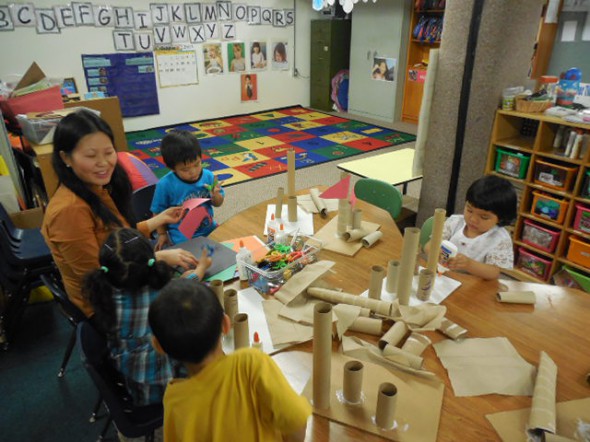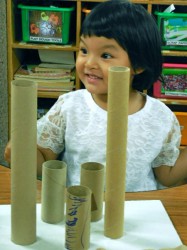A School for Refugees
Neighborhood House pre-school program teaches Burmese and African refugee children.

Daily art projects help the ILC preschool students develop their social-emotional and cognitive skills. (Photo by Maria Corpus)
Upon arriving at the International Learning Center, 639 N. 25th St., parents make a quick stop at the center’s preschool to drop off their children before continuing on to attend their English as a Second Language class. At the preschool, the children learn similar lessons as their parents. Shapes, colors and the alphabet are among the lessons for the day.
The International Learning Center preschool, a program of the Neighborhood House of Milwaukee Inc., supports refugee families by working with children and developing their literacy, social-emotional and cognitive skills, said Early Childhood Services Manager Phan Sanford.
“One thing that some people don’t realize is that when [the] parents are limited as far as their English language goes, it’s very difficult for the child to learn the skills that they need prior to kindergarten,” Sanford added.

Win Yin Khoing, 3, has attended the preschool for a year and is seen as a class leader by her peers and her teacher, Bao Her. (Photo by Maria Corpus)
The preschool is open to children ages 2-1/2 to 5, and is offered exclusively to parents who attend ILC English courses. Families are referred by resettlement agencies and learn about ILC by word of mouth, said Instructional Supervisor Cynthia Zarazua.
The preschool is home to Burmese and African refugee children, according to ILC preschool teacher Bao Her, who the children call “Miss Bao.”
Hser Blu Hai is one of eight children who attend the preschool’s first morning session. He has come a long way since his first days at the center’s preschool.
“He cried for three months…He either cried until he [fell asleep] or he cried until mom came back. It’s very hard and terrifying for the children when they don’t know the language and can’t communicate,” Her said.
Now when he arrives, Hser Blu plays comfortably with the other students, sings the “Baby Bumble Bee” song during story time and creates castles as part of the day’s art activity.
The terrifying days also are in the past for Win Yin Khoing, age 3. After a year at the preschool, Khoing is a class leader. Her familiarity with the classroom and her English skills make her a model for the newer students.
Her admits that it can be challenging to work with as many as eight students who are at different English levels. Action pictures are used to communicate with the newer children in the program. For example, one action picture illustrates a group sitting down and reading books, while another displays a sink and children washing their hands.
Lesson plans teaching colors, shapes and the alphabet include art projects, songs and story time. Labeled objects also help children with their literacy skills. The play area contains bins with pictures and labels such as “Yellow Truck” and “Zoo Animals” to assist the children in learning these words.
Her noted that children show dramatic improvement during their time at the preschool. Some children even translate for their parents during home visits, she added.
Home visits are “an extension of the classroom where we visit the children in their home with their parents and we’re working on activities that are individualized to the family,” Sanford said.
During the weekly visits, Her focuses on safety. She also educates the family on life in America and addresses any concerns a family has.
“I’m here to be [the family’s] partner; I’m here to help them,” she said.
This story was originally published by Milwaukee Neighborhood News Service, where you can find other stories reporting on fifteen city neighborhoods in Milwaukee.


















